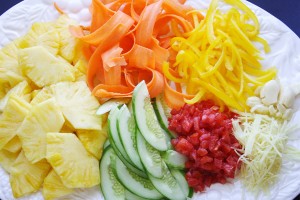Tastes Like Home
Hi Everyone, For almost two decades I have not touched or tasted a sweet and sour dish. Hold on, two decades?! Man I’m old! Sorry for the digression… As I was saying, when dining, I have stayed away from all offerings of sweet and sour because when I had tasted it for the first time as a teenager I had decided then and there that I didn’t like it. Granted that my palate was not as developed as it is now, I nevertheless found that the sauce needed to get over its split personality – was it sweet or sour because the combo just was not working, at least not for me.

For several years now I’ve been enjoying a hot-sweet-salty affair with combinations such as guava cheese paired with blue cheese, marmalade with habanero sharp cheddar, Bartlett pears with sea salt etc. As a result, I thought that I’d give sweet and sour another chance to woo me.
This time around, when looking for a recipe and guidance, I headed straight to my bookshelf for Kylie Kwong’s tome – Simple Chinese Cooking. I had bookmarked the recipe to try ever since the book was released in 2006 – that’s how long I’ve had this date with Kylie’s sweet and sour sauce. What attracted me to the sauce immediately was the use of fresh ingredients and how simple it was going to be to make and assemble the sauce. Armed with the list of ingredients I went shopping. I was going to be making sweet and sour pork.
Given that this was a new combination of flavours for me to cook, I followed the recipe precisely and threw out my impulse to add my own touch to the dish. The sauce was made in 15 minutes, that’s excluding prep time – slicing of vegetables. I timidly tasted the sauce by putting a few drops in the palm of my hand – as I brought my hand to my mouth, I could smell the fruitiness of the sauce. I tasted the sweet first and then the sour halfway through, I kid you not it was exactly like that, half and half and in that order – sweet and sour. Not bad at all I thought. I quickly set about cooking the pork. There are some things that in order for you to get the proper taste you need to eat-taste it with the required accompaniment. For example, whenever I make pepperpot, though I taste a little of the sauce by itself, I always put some of the sauce into a bowl and dip with bread and taste it, it is the best way for me to verify the taste and know what I need to do to make adjustments if necessary. Given that I was making the sauce to eat with pork, I wanted to wait for my final evaluation after I had tasted the sweet and sour sauce with the pork.
As soon as the first batch of pork was finished frying, I dipped a couple into some sauce. I popped the first piece into my mouth and the party started immediately – sweet, salt and sour were to put it in the words of a Bajan friend of mine, “wukking up”. I ate the other piece and hummed happily as I finished cooking the rest of the pork. With a little bowl of pork, some sauce and veggies on the side I sat down to enjoy my meal of sweet and sour pork. Eating it with the suggested steamed rice is excellent as the rice acts almost as a palate cleanser between mouthfuls thereby making each taste of the sweet and sour sauce a welcoming experience.

I’m now spoilt for sweet and sour sauce. What that means is that rather than not eat it at all, I’m inclined to be super-selective about where and from whom I eat sweet and sour sauce. Sorry, none of the fuchsia-red-coloured goo for me. When you make the sauce yourself and taste it, you will say the same thing, it is that good.
Originated in China, sweet and sour sauce has taken on many versions and variations depending on where you are located. As with many dishes, it has been adapted to its transplanted locations. Some of the effects of that adaptation have to do with the availability or non-availability of ingredients; the other important key to that adaptation is the need to suit the palates of those being catered to.
Sweet and sour sauce can be used in two ways, either as a dipping sauce or poured over. Personally, I prefer to use the dipping method as poured over your food, I found that it can be a little overwhelming in taste. Dipping I find allows for more of a flavourful and textural enjoyment of the dish. On one end you’ll get to taste the sweet and sour as it interacts with the savouriness and other flavourings used on the cooked food.
The sweet in sweet and sour sauce comes from the sugar used and the sour comes from the vinegar. As with most things, personal taste will dictate the ratio of sugar to vinegar and vice versa. If you’re looking for that red colour in your sauce, then tomato ketchup will do the trick.
Are you a fan of sweet and sour? Come over to my blog and tell me about it.
Cynthia
